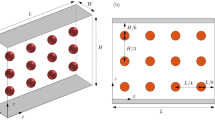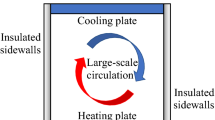Abstract
With a single-phase approach, a 3D mathematical model was developed through Computational Fluid Dynamics (CFD) techniques, coupling the momentum and heat transfer balances for the study of the thermal behaviour of nanofluids. The local heat transfer coefficient and thermal boundary layer thickness of CuO/water, Fe2O3/water and Al2O3/water nanofluids, have been predicted and compared with those experimentally determined at three volume concentration of nanoparticles (ϕ=0.01%, 0.03% and 0.05%), at T = 25 °C and T = 55 °C for laminar and turbulent flow conditions, using a newly developed sophisticated noninvasive heat transfer coefficient probe that is flush mounted on the inner wall of the test section. Such conditions have been used for the mathematical model, considering the effects of the nanoparticle materials and volume concentrations through effective thermophysical properties. The predicted results from the mathematical model show a good agreement with the trend and the experimental observations. The enhancement of the heat transfer coefficient and reduction of the thermal boundary layer when increasing the volume concentration of the nanofluids and when increasing the flow rates have been properly predicted by the mathematical model results, showing average absolute relative errors between 1.7% and 8.4%. The model exhibits an enhancement in the agreement between the experimental measurements and the predicted results when comparing with other models found in literature.

















Similar content being viewed by others
Abbreviations
- CFD :
-
Computational Fluid Dynamics
- C p :
-
Heat capacity \( \left[\frac{J}{kgK.}\right] \)
- g :
-
Gravity acceleration \( \left[\frac{m}{s^2}\right] \)
- h :
-
Local heat transfer coefficient \( \left[\frac{W}{m^2K}\right] \)
- H :
-
Enthalpy of the fluid [J]
- I :
-
Identity matrix
- k :
-
Turbulent kinetic energy
- K :
-
Thermal conductivity \( \left[\frac{W}{mK}\right] \)
- n :
-
Normal vector
- P :
-
Absolute pressure [Pa]
- q :
-
Heat flux \( \left[\frac{W}{m^2}\right] \)
- \( \dot{Q} \) :
-
Flow rate \( \left[\frac{l}{\mathit{\min}}\right] \)
- T :
-
Temperature [K]
- v :
-
Fluid velocity \( \left[\frac{m}{s}\right] \)
- δ :
-
Thermal boundary layer [mm]
- ε :
-
Turbulent dissipation rate
- ϕ :
-
Volume concentration
- μ :
-
Dynamic viscosity [Pa s]
- ρ :
-
Density \( \left[\frac{kg}{m^3}\right] \)
- 0:
-
Initial conditions
- B :
-
Bulk
- nf :
-
nanofluid
- np :
-
Nanoparticle
- s :
-
surface
- w :
-
Water
References
Naik BAK, Vinod AV (2018) Heat transfer enhancement using non-Newtonian nanofluids in a shell and helical coil heat exchanger. Exp Thermal Fluid Sci 90:132–142. https://doi.org/10.1016/j.expthermflusci.2017.09.013
Sahota L, Shyam TGN (2017) Energy matrices, enviroeconomic and exergoeconomic analysis of passive double slope solar still with water based nanofluids. Desalination 409:66–79. https://doi.org/10.1016/j.desal.2017.01.012
Ahmadi M, Willing G (2018) Heat transfer measurment in water based nanofluids. Int J Heat Mass Transf 118:40–47. https://doi.org/10.1016/j.ijheatmasstransfer.2017.10.090
Behroyan I, Ganesan P, He S, Sivasankaran S (2015) Turbulent forced convection of cu-water nanofluid: CFD model comparison. International Communications in Heat and Mass Transfer 67:163–172. https://doi.org/10.1016/j.icheatmasstransfer.2015.07.014
Kakaç S, Pramuanjaroenkij A (2009) Review of convective heat transfer enhancement with nanofluids. Int J Heat Mass Transf 52:3187–3196. https://doi.org/10.1016/j.ijheatmasstransfer.2009.02.006
Yu W, France DM, Routbort JL, Choi SUS (2008) Review and comparison of nanofluid thermal conductivity and heat transfer enhancements. Heat Transfer Engineering 29:432–460. https://doi.org/10.1080/01457630701850851
Daungthongsuk W, Wongwises S (2007) A critical review of convective heat transfer of nanofluids. Renew Sust Energ Rev 11:797–817
Sun B, Peng C, Zuo R et al (2016) Investigation on the flow and convective heat transfer characteristics of nanofluids in the plate heat exchanger. Exp Thermal Fluid Sci 76:75–86. https://doi.org/10.1016/j.expthermflusci.2016.03.005
Wu D, Zhu H, Wang L, Liu L (2009) Critical issues in nanofluids preparation, characterization and thermal conductivity. Curr Nanosci 5:103–112
Keblinski P, Phillpot SR, Choi SUS, Eastman JA (2001) Mechanisms of heat flow in suspensions of nano-sized particles (nanofluids). Int J Heat Mass Transf 45:855–863. https://doi.org/10.1016/S0017-9310(01)00175-2
Xuan Y, Li Q (2000) Heat transfer enhancement of nanofluids. Int J Heat Fluid Flow 21:58–64. https://doi.org/10.1016/S0142-727X(99)00067-3
Zeinali Heris S, Nasr Esfahany M, Etemad SG (2007) Experimental investigation of convective heat transfer of Al2O3/water nanofluid in circular tube. Int J Heat Fluid Flow 28:203–210. https://doi.org/10.1016/j.ijheatfluidflow.2006.05.001
Yazdanifard F, Ameri M, Ebrahimnia-Bajestan E, Ebrahimnia-Bajestan E (2017) Performance of nanofluid-based photovoltaic/thermal systems: a review. Renew Sust Energ Rev 76:323–352. https://doi.org/10.1016/j.rser.2017.03.025
Pak BC, Cho YI (1998) Hydrodynamic and heat transfer study of dispersed fluids with submicron metallic oxide particles. Experimental Heat Transfer 11:151–170. https://doi.org/10.1080/08916159808946559
Sun B, Lei W, Yang D (2015) Flow and convective heat transfer characteristics of Fe2O3-water nanofluids inside copper tubes. International Communications in Heat and Mass Transfer 64:21–28. https://doi.org/10.1016/j.icheatmasstransfer.2015.01.008
Mikkola V, Puupponen S, Granbohm H et al (2018) Influence of particle properties on convective heat transfer of nanofluids. Int J Therm Sci 124:187–195. https://doi.org/10.1016/j.ijthermalsci.2017.10.015
Xuan Y, Li Q (2003) Investigation on convective heat transfer and flow features of nanofluids. J Heat Transf 125:151–155. https://doi.org/10.1115/1.1532008
Manay E, Sahin B, Akyürek E, Çomaklı Ö (2012) Use of nanofluids in microchannels. Engineering and Machine 627:28–42
Farajollahi B, Etemad SG, Hojjat M (2010) Heat transfer of nanofluids in a shell and tube heat exchanger. Int J Heat Mass Transf 53:12–17. https://doi.org/10.1016/j.ijheatmasstransfer.2009.10.019
Wen D, Ding Y (2004) Experimental investigation into convective heat transfer of nanofluids at the entrance region under laminar flow conditions. Int J Heat Mass Transf 47:5181–5188. https://doi.org/10.1016/j.ijheatmasstransfer.2004.07.012
Gupta NK, Tiwari AK, Ghosh SK (2018) Heat transfer mechanisms in heat pipes using nanofluids – a review. Exp Thermal Fluid Sci 90:84–100. https://doi.org/10.1016/j.expthermflusci.2017.08.013
Kim S, Song H, Yu K et al (2018) Comparison of CFD simulations to experiment for heat transfer characteristics with aqueous Al2O3 nanofluid in heat exchanger tube. International Communications in Heat and Mass Transfer 95:123–131. https://doi.org/10.1016/j.icheatmasstransfer.2018.05.005
Heris SZ, Etemad SG, Esfahany MN (2006) Experimental investigation of oxide nanofluids laminar flow convective heat transfer. International Communications in Heat and Mass Transfer 33:529–535. https://doi.org/10.1016/j.icheatmasstransfer.2006.01.005
Duangthongsuk W, Wongwises S (2009) Heat transfer enhancement and pressure drop characteristics of TiO2-water nanofluid in a double-tube counter flow heat exchanger. Int J Heat Mass Transf 52:2059–2067. https://doi.org/10.1016/j.ijheatmasstransfer.2008.10.023
Zouli N, Said IA, Al-Dahhan M (2019) Enhancement of thermal conductivity and local heat transfer coefficients using Fe2O3/water nanofluid for improved thermal desalination processes. Journal of Nanofluids 8:2203–1122
Kumar S, Kothiyal AD, Bisht MS, Kumar A (2017) Turbulent heat transfer and nanofluid flow in a protruded ribbed square passage. Results in Physics 7:3603–3618. https://doi.org/10.1016/j.rinp.2017.09.023
Akbari M, Galanis N, Behzadmehr A (2011) Comparative analysis of single and two-phase models for CFD studies of nanofluid heat transfer. Int J Therm Sci 50:1343–1354. https://doi.org/10.1016/j.ijthermalsci.2011.03.008
Kamyar A, Saidur R, Hasanuzzaman M (2012) Application of computational fluid dynamics (CFD) for nanofluids. Int J Heat Mass Transf 55:4104–4115. https://doi.org/10.1016/j.ijheatmasstransfer.2012.03.052
Mk A, Azwadi C, Mamat R et al (2015) Nanofluids heat transfer enhancement through straight channel under turbulent flow. International Journal of Automotive and Mechanical Engineering (IJAME) 11:2294–2305. https://doi.org/10.15282/ijame.11.2015.12.0193
Habibi MR, Amini M, Arefmanesh A, Ghasemikafrudi E (2019). Effects of viscosity variations on buoyancy-driven flow from a horizontal circular cylinder immersed in Al 2 O 3-water Nanofluid. Iran J Chem Chem Eng 38:
Xu Z, Kleinstreuer C (2014) Concentration photovoltaic-thermal energy co-generation system using nanofluids for cooling and heating. Energy Convers Manag 87:504–512. https://doi.org/10.1016/j.enconman.2014.07.047
Pendyala R, Ilyas SU, Lim LR, Marneni N (2016). CFD analysis of heat transfer performance of Nanofluids in distributor transformer. In: Procedia Engineering. Elsevier Ltd, pp. 1162–1169
Lee JH, Hwang KS, Jang SP et al (2008) Effective viscosities and thermal conductivities of aqueous nanofluids containing low volume concentrations of Al2O3 nanoparticles. Int J Heat Mass Transf 51:2651–2656. https://doi.org/10.1016/j.ijheatmasstransfer.2007.10.026
Bird RB, Stewart WE, Lightfoot EN (2002). Transport phenomena
Shih T, Liou W, Shabir A, et al (1994). A new k-e Eddy viscosity model for high Reynolds number turbulent flows-model development and validation
Wilcox DC (1993). Turbulence modeling for CFD, 2nd ed. DCW Industries
Kuzmin D, Mierka O, Turek S (2007) On the implementation of the k − ε turbulence model in incompressible flow solvers based on a finite element discretization. IntJ Computing Science and Mathematics 1:193–206
Grotjans H, Menter F (1998). Wall functions for general application CFD codes. In: Proceedings of the Fourth European Computational Fluid Dynamics Conference. John Wiley & Sons, pp. 1112–1117
Pope S (2000). Turbulent flow. Cambridge University Press
Ferguson JD, Walters DK, Leylek JH (1998). Performance of turbulence models and near-wall treatments in discrete jet film cooling simulations. In: Proceedings of the ASME Turbo Expo. American Society of Mechanical Engineers (ASME)
Schoppa W, Hussain F (2002) Coherent structure generation in near-wall turbulence. J Fluid Mech 453:57–108. https://doi.org/10.1017/S002211200100667X
Kays WK (1994) Turbulent Prandtl number. Where are we? ASME Transactions Journal of Heat Transfer 116:284–295
Lacasse D, Turgeon É, Pelletier D (2004) On the judicious use of the k-ε model, wall functions and adaptivity. Int J Therm Sci 43:925–938. https://doi.org/10.1016/j.ijthermalsci.2004.03.004
Poling BE, Prausnitz JM, O’Connell JP, John P (2001) The properties of gases and liquids. McGraw-Hill
Xuan Y, Roetzel W (2000) Conceptions for heat transfer correlation of nanofluids. Int J Heat Mass Transf 43:3701–3707. https://doi.org/10.1016/S0017-9310(99)00369-5
Einstein A (1906). Eine neue Bestimmung der Moleküldimensionen. Ann Phys 289–306
Maxwell J (1881). A treatise on electricity and magnetism, 11th ed. Calderon Press
Zouli NI, Mohammed SAM, Al-Dahhan M (2017). Enhancement of heat transfer coefficient using Fe2O3 – water nanofluids. Materials for Energy, Efficiency, and Sustainability: TechConnect Briefs 247–250
Jung JY, Oh HS, Kwak HY (2009) Forced convective heat transfer of nanofluids in microchannels. Int J Heat Mass Transf 52:466–472. https://doi.org/10.1016/j.ijheatmasstransfer.2008.03.033
Yang Y, Zhang ZG, Grulke EA et al (2005) Heat transfer properties of nanoparticle-in-fluid dispersions (nanofluids) in laminar flow. Int J Heat Mass Transf 48:1107–1116. https://doi.org/10.1016/j.ijheatmasstransfer.2004.09.038
Gnielinski V (1976) New equations for heat and mass transfer in turbulent pipe and channel flow. Int Chem Eng 16:359–368
Winterton RHS (1997) Where did the Dittus and Boelter equation come from? Int J Heat Mass Transf 41:809–810
Funding
This research did not receive any specific grant from funding agencies in the public, commercial, or not-for-profit sectors
Author information
Authors and Affiliations
Corresponding author
Ethics declarations
Conflict of interest
On behalf of all authors, the corresponding author states that there is no conflict of interest
Additional information
Publisher’s note
Springer Nature remains neutral with regard to jurisdictional claims in published maps and institutional affiliations.
Highlights
- A single-phase approach mathematical model was developed for nanofluids
- The effect of nanoparticles was incorporated through effective properties
- Prediction of heat transfer coefficients in good agreement with experiments
- High predictive quality of the enhancement of the heat transfer coefficient
- Improvement in the predictive quality in comparison with other literature models
Rights and permissions
About this article
Cite this article
Uribe, S., Zouli, N., Cordero, M.E. et al. Development and validation of a mathematical model to predict the thermal behaviour of nanofluids. Heat Mass Transfer 57, 93–110 (2021). https://doi.org/10.1007/s00231-020-02927-5
Received:
Accepted:
Published:
Issue Date:
DOI: https://doi.org/10.1007/s00231-020-02927-5




